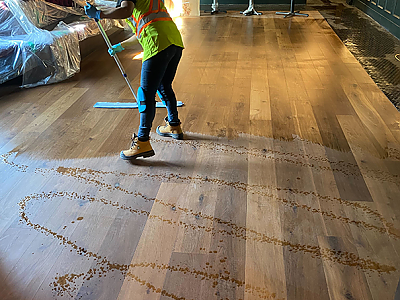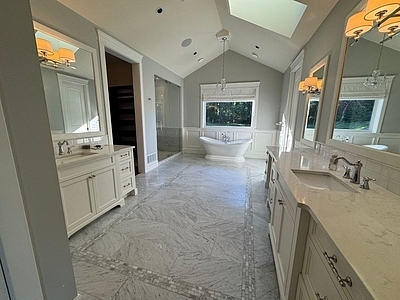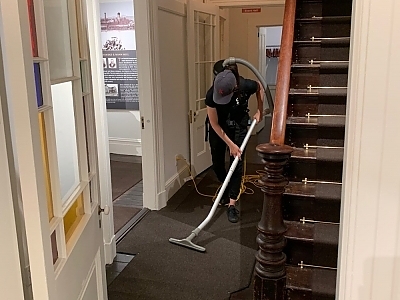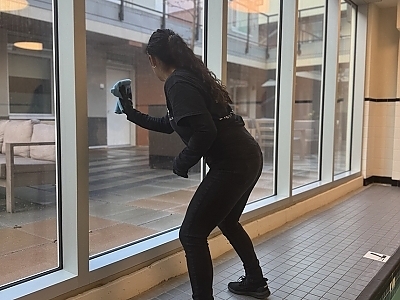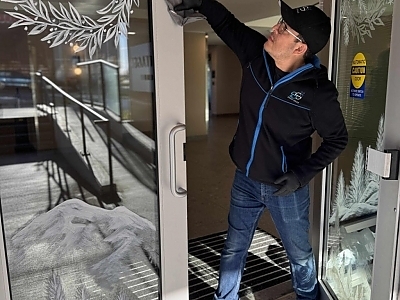Cleaning Protocols for Dental and Medical Offices
Keeping dental and medical offices clean is absolutely vital for patient safety and stopping the spread of infections. These offices need to follow strict cleaning rules to keep patients and staff safe and healthy. Let's dive into the key aspects of cleaning in healthcare environments, including medical office cleaning and dental office disinfection in Victoria.
Why Cleaning Protocols Matter
The main goal of healthcare cleaning protocols is to lower the risk of infection. This is super important in areas where patients are vulnerable or getting procedures that could expose them to infections. Proper cleaning and disinfecting practices are the first line of defense against harmful germs spreading.
Infections picked up in healthcare settings, called healthcare-associated infections (HAIs), can have really serious consequences for patients. We're talking longer hospital stays, higher medical costs, and even life-threatening complications in some cases. By having rigorous cleaning protocols in place, healthcare facilities can drastically reduce the risk of HAIs and protect patients from preventable infections.
Plus, a visibly clean and well-kept facility instills confidence in patients and families. It shows that the healthcare provider really cares about patient safety and cleanliness standards.
Standard Cleaning Guidelines
Health authorities like the CDC provide standard cleaning guidelines for medical environments. These guidelines lay out best practices for cleaning surfaces, equipment, and patient care areas to maintain a high level of hygiene. Following these standards helps ensure consistent cleanliness across all healthcare facilities, including those offering healthcare cleaning services in Victoria.
The CDC guidelines cover things like choosing the right disinfectants, how to properly dilute and apply them, contact times, and disposal methods. They also give specific recommendations for cleaning different surface types like floors, walls, and medical equipment.
Sticking to these guidelines is crucial for making sure cleaning protocols are effective and consistent throughout the healthcare facility. It also establishes a baseline for training and auditing purposes, so all staff follow the same procedures and standards.
| Guideline | Importance |
|---|---|
| Disinfectant Selection | Choosing the right disinfectant for the surface type and contamination level is key for effective disinfection. |
| Contact Time | Letting the disinfectant sit on the surface for the recommended time ensures germs are properly killed. |
| Surface Preparation | Properly cleaning and removing visible debris before disinfecting enhances the disinfectant's effectiveness. |
| Personal Protective Equipment (PPE) | Wearing proper PPE like gloves and eye protection keeps cleaning staff safe from hazardous materials. |
| Waste Disposal | Properly disposing of contaminated materials and disinfectant solutions prevents environmental contamination. |
| Documentation | Keeping records of cleaning procedures and disinfectant use ensures compliance and makes auditing easier. |
Daily Cleaning Routines
Daily cleaning routines are essential for maintaining a clean environment. This includes regularly cleaning high-touch surfaces, patient care areas like waiting rooms, exam rooms, and dental operatories. Each area needs careful attention to detail to ensure all surfaces are properly disinfected.
High-touch surfaces like door handles, countertops, and light switches are especially prone to harboring and spreading germs. These surfaces should be cleaned and disinfected multiple times throughout the day since patients, staff, and visitors are constantly touching them.
Patient care areas, including waiting rooms, exam rooms, and dental operatories, require a thorough cleaning and disinfection after each patient visit. This involves wiping down all surfaces, disinfecting equipment, and properly disposing of any contaminated materials. Hard-to-clean areas like crevices and corners can't be missed.
- Use EPA-registered disinfectants approved for healthcare settings
- Follow manufacturer's instructions for proper dilution and contact time
- Use color-coded cleaning cloths and mops to prevent cross-contamination
- Clean from least soiled to most soiled areas
- Replace cleaning solutions and equipment regularly
- Ensure proper ventilation during cleaning and disinfection
- Document cleaning procedures and maintain records
- Train staff on proper cleaning techniques and safety protocols
Cleaning Dental Instruments & Medical Equipment
Special care is needed when cleaning and disinfecting dental instruments and medical equipment. These items come into close contact with patients, so they must be sterilized to prevent the spread of germs. Using the right disinfectants and sterilization techniques is crucial.
Dental instruments and medical equipment should be cleaned and disinfected right after use, following the manufacturer's instructions. This may involve manual cleaning, ultrasonic cleaning, or using specialized disinfecting equipment like autoclaves or sterilizers.
It's essential to follow strict protocols for handling and transporting contaminated instruments and equipment to stop the spread of infections. Staff should be trained on proper handling techniques and using personal protective equipment (PPE) to minimize exposure risk.
Disinfectants & Surface Cleaning
Choosing the right disinfectants for different surface types and equipment is essential. Not all disinfectants work for every surface, and using the wrong type can damage equipment or fail to eliminate germs effectively.
Healthcare facilities need to understand the different types of disinfectants available and their appropriate uses. For example, quaternary ammonium compounds may work for cleaning non-porous surfaces, while chlorine-based disinfectants may be better for cleaning up blood spills or bodily fluids.
It's also important to follow the manufacturer's instructions for proper dilution, contact time, and application methods to ensure the disinfectant is effective. Using the wrong concentration or not letting it sit long enough can render the disinfectant useless, putting patients and staff at risk.
Handling Biohazardous Waste
Proper protocols for handling and disposing of biohazardous waste, including sharps and contaminated materials, are crucial. This ensures potentially infectious materials are dealt with safely, reducing the risk of exposure to staff and patients.
Biohazardous waste should be separated from regular waste and stored in clearly labeled, leak-proof containers. These containers should be handled with care and transported to designated disposal areas following strict safety protocols.
Sharps like needles and scalpels pose a particular injury and bloodborne pathogen exposure risk. They should be disposed of immediately after use in puncture-resistant containers and handled with extreme caution during transportation and disposal.
Staff Training & Safety
Training cleaning staff on the proper use of disinfectants and protective measures is crucial to prevent the spread of germs and ensure their safety. Staff should be well-informed about the risks and the importance of following cleaning protocols carefully.
Regular training sessions should cover topics like proper hand hygiene, using personal protective equipment (PPE), safely handling biohazardous materials, and correctly applying disinfectants. Staff should also be trained on properly disposing of contaminated materials and maintaining a clean and organized work environment.
In addition to training, healthcare facilities should provide their cleaning staff with the necessary PPE like gloves, gowns, and face masks to protect them from potential exposure to infectious agents. Regular health screenings and immunizations may also be necessary to ensure staff safety.
Air Quality & Deep Cleaning
Regularly maintaining air filtration systems and doing deep cleanings play a big role in improving indoor air quality. These measures help reduce airborne contaminants and maintain a healthy environment.
Air filtration systems like HVAC filters should be regularly inspected and replaced according to manufacturer recommendations. This helps remove airborne particles like dust, pollen, and potential germs from the indoor environment.
Deep cleaning, which involves a thorough cleaning of all surfaces, equipment, and hard-to-reach areas, should be done regularly. This can remove any accumulated dirt, dust, or debris that may have been missed during daily cleaning routines. Deep cleaning can also help prevent the buildup of potentially harmful microorganisms in hard-to-reach areas.
Hand Hygiene & PPE
Hand hygiene and using personal protective equipment (PPE) go hand-in-hand with cleaning protocols. These practices are essential for breaking the chain of infection and protecting healthcare workers and patients.
Proper hand hygiene, which includes washing hands with soap and water or using an alcohol-based hand sanitizer, should be practiced by all staff before and after patient contact, after handling contaminated materials, and after removing PPE. Hand hygiene stations should be readily available throughout the facility to encourage compliance.
PPE like gloves, gowns, and face masks should be worn by staff when there's a risk of exposure to bodily fluids or infectious materials. The type of PPE required will depend on the specific task being performed and the level of potential exposure.
Checklists & Schedules
Implementing a checklist or schedule ensures that all cleaning tasks are completed thoroughly and consistently. This helps maintain a routine and ensures no areas are overlooked during the cleaning process.
Checklists can outline the specific cleaning tasks required for each area of the facility, including the surfaces to be cleaned, the disinfectants to be used, and the frequency of cleaning. These checklists can be customized to meet the specific needs of the healthcare facility and can be used as a training tool for new staff members.
Schedules can be developed to ensure that cleaning tasks are performed at regular intervals, such as daily, weekly, or monthly. These schedules can also be adjusted to account for periods of increased activity or potential outbreaks, ensuring that cleaning protocols are adapted to meet the changing needs of the facility.
- Assign specific staff members to each cleaning task or area
- Incorporate visual cues or color-coding for easy identification of areas or tasks
- Include instructions for proper use of cleaning equipment and supplies
- Provide space for documentation and sign-off upon task completion
- Review and update checklists and schedules regularly based on feedback and audits
- Ensure checklists and schedules are easily accessible to all cleaning staff
- Conduct regular training and refreshers on the use of checklists and schedules
Adapting to Outbreaks
Cleaning protocols may need to be adapted in response to outbreaks of infectious diseases. Increasing the frequency of cleaning and focusing on areas that are more likely to harbor viruses are steps that can be taken during such times.
During an outbreak, it may be necessary to increase the frequency of cleaning in high-traffic areas, such as waiting rooms and common areas. Additionally, special attention should be paid to surfaces that are frequently touched, such as door handles, countertops, and handrails.
Healthcare facilities may also need to implement additional precautions, such as the use of specialized disinfectants or the implementation of enhanced cleaning protocols in areas where infected patients are being treated. These measures can help to prevent the further spread of the infectious agent and protect both patients and staff.
Patient Education
Educating patients on office cleanliness and infection prevention measures contributes to a safer environment. It encourages cooperation and understanding of the measures taken by the healthcare facility to protect their health.
Patient education can take many forms, such as informational brochures, posters, or videos displayed in waiting areas. These materials can explain the importance of hand hygiene, the use of PPE, and the cleaning protocols followed by the facility.
Additionally, healthcare providers can take the opportunity to educate patients during appointments or consultations. This can help to reinforce the importance of cleanliness and infection prevention, and encourage patients to take an active role in maintaining a safe and healthy environment.
Regular Audits & Updates
Conducting regular audits and updating cleaning protocols based on new research and guidelines from health organizations ensure that practices remain effective and up-to-date.
Audits can be performed internally or by external agencies to assess the effectiveness of cleaning protocols and identify areas for improvement. These audits may involve visual inspections, surface testing, or reviewing documentation and records.
As new research and guidelines become available, healthcare facilities should review and update their cleaning protocols accordingly. This may involve incorporating new disinfectants, adjusting contact times, or implementing new cleaning techniques to ensure that the facility is following the latest best practices.
Professional Cleaning Services
Collaborating with professional cleaning services specialized in healthcare facilities can provide comprehensive cleaning solutions. These services have the expertise and equipment necessary to meet the high standards required in healthcare settings.
Professional cleaning services can offer a range of services, including daily cleaning, deep cleaning, and specialized cleaning for areas such as operating rooms or isolation units. They can also provide training and support to ensure that cleaning protocols are followed consistently and effectively.
By partnering with a reputable cleaning service, healthcare facilities can benefit from the latest cleaning technologies and techniques, as well as access to specialized equipment and products that may not be readily available in-house. This can help to ensure that the facility maintains the highest standards of cleanliness and infection control.
Maintaining a clean and safe environment in dental and medical offices is a collective effort that requires attention to detail, adherence to guidelines, and continuous improvement. By following these protocols, healthcare facilities can provide a safe space for patients and staff alike.
Swept Space focuses on keeping the highest standards of cleanliness and safety for our medical and dental office clients in the Victoria, BC area. We have the knowledge, tools, and skills needed to provide high-quality cleaning services for the healthcare industry.
Don't risk the health and safety of your patients and staff. Contact Swept Space for your medical cleaning or give us a call at 250-412-3522.
‹ Back



